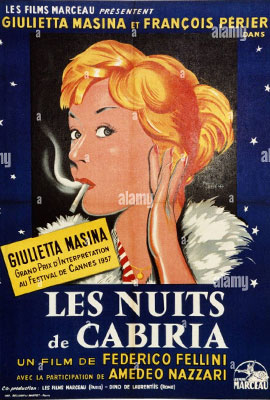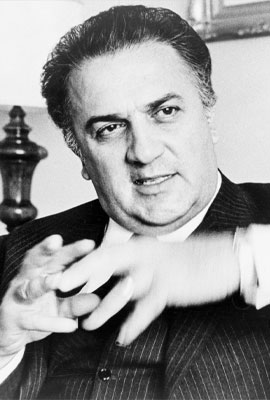
(1954)
directed by Federico Fellini
Fellini started film making during the neorealist era of Italian cinema. His early films, including “La Strada” and “Nights of Cabiria,” are filmed in black and and white and have the gritty quality associated with Italian neorealist films.
“Nights of Cabiria” opens with Cabiria and her lover running in a field. They stop and embrace several times. When they reach the banks of a river, the man takes Cabiria’s purse and runs away. Cabiria falls into the river and begins to drown. She is saved by some young boys who happen to be nearby.
When she returns home, one of her friends tries to make her understand that Giorgio, the man who took her purse, and whom she has only known for a short while, actually robbed her. Cabiria is under the impression that she had accidentally fallen into the river. She doesn’t want to believe that Giorgio would do such a thing to her. This scene introduces us to Cabiria’s innocence.
Cabiria’s eyebrows are horizontal lines drawn above her eyes like a cartoon character’s. Her shrug, her walk, everything about her, reminds us of Chaplin’s Little Tramp. No matter what happens, she remains as waifish and childlike as ever. Cabiria, played by Fellini’s wife, Giulietta Masina, is a prostitute who hopes for a better life.
The film follows her adventures in the city of Rome and in her poverty stricken neighborhood near the city. Cabiria is strong and defiant. She is proud to own her own home, even though it is just a shack. When an audience at a club is rude to her, she responds by informing the audience that she has a bank account and owns a house.
In one of the film’s most extraordinary scenes, Cabiria happens upon a performance by a hypnotist. She is called on stage and is placed in a trance during which she reveals her innocence, her sweetness, and her hopes of eventually finding true love with an imaginary Oscar. A man, who calls himself Oscar, sees her on the stage. Oscar begins to court Cabiria with flowers and seeming sincerity. Cabiria is overjoyed. At last she has found a man she can trust, a man she can spend the rest of her life with! Her friends, however, along with the audience, despair of her naivete. Of all his characters, Fellini once said, Cabiria was the only one he was still worried about.
Oscar promises to marry Cabiria. She sells her house and takes the cash from the sale along with the cash in her bank account to Oscar so they can pool their money together for their marriage. Cabiria accompanies Oscar to a cliff where Oscar wants to show her the sunset. There she suddenly realizes that Oscar plans to kill her. Oscar tells her that he doesn’t want to hurt her but takes all of her money.
In the last scene of the film, a distraught Cabiria is walking alone on a road. She joins a parade of young people who are singing, dancing, and playing music. A single tear, black with mascara, streaks her cheek and makes her look like a clown. Cabiria looks directly at the camera and smiles as if to assure us that everything will be all right. Cabiria’s smile is a gift to all of humanity and is one of the greatest moments in all of cinema.
Federico Fellini

Federico Fellini, the director of “Nights of Cabiria,” is known for films that blend fantasy and earthiness. Fellini turns again and again to certain images: the circus, parades, the seashore, and a figure suspended between earth and sky. You will find journeys, processions, clowns, freaks, and the melancholy of a field at dawn after the circus has left. Fellini would rework these images until the end of his life.
In childhood, Fellini discovered the world of Grand Guignol, the circus with Pierino the Clown. Later, after he became a famous filmmaker, Fellini said, “The clown is always the caricature of a well-established, ordered, peaceful society. But today all is temporary, disordered, grotesque. All the world plays a clown now.”
Before his career as a filmmaker, Fellini achieved success while employed at Marc’Aurelio, a very popular humor magazine. Fellini met his future wife, Giulietta Masina, in a studio office. Masina was already famous for her musical-comedy broadcasts during the second World War. Their partnership was crucial. Working together they created timeless, unforgettable characters, and truly extraordinary movies.
Fellini’s overriding concern with developing a poetic form of cinema was outlined in an interview with The New Yorker journalist Lillian Ross, “I am trying to free my work from certain constrictions, a story with a beginning, a development, an ending. It should be more like a poem with metre and cadence.”
Fellini is recognized as one of the greatest and most influential filmmakers of all time. He was nominated for twelve Academy Awards and won four in the category of Best Foreign Language Film, the most for any director in the history of the Academy.